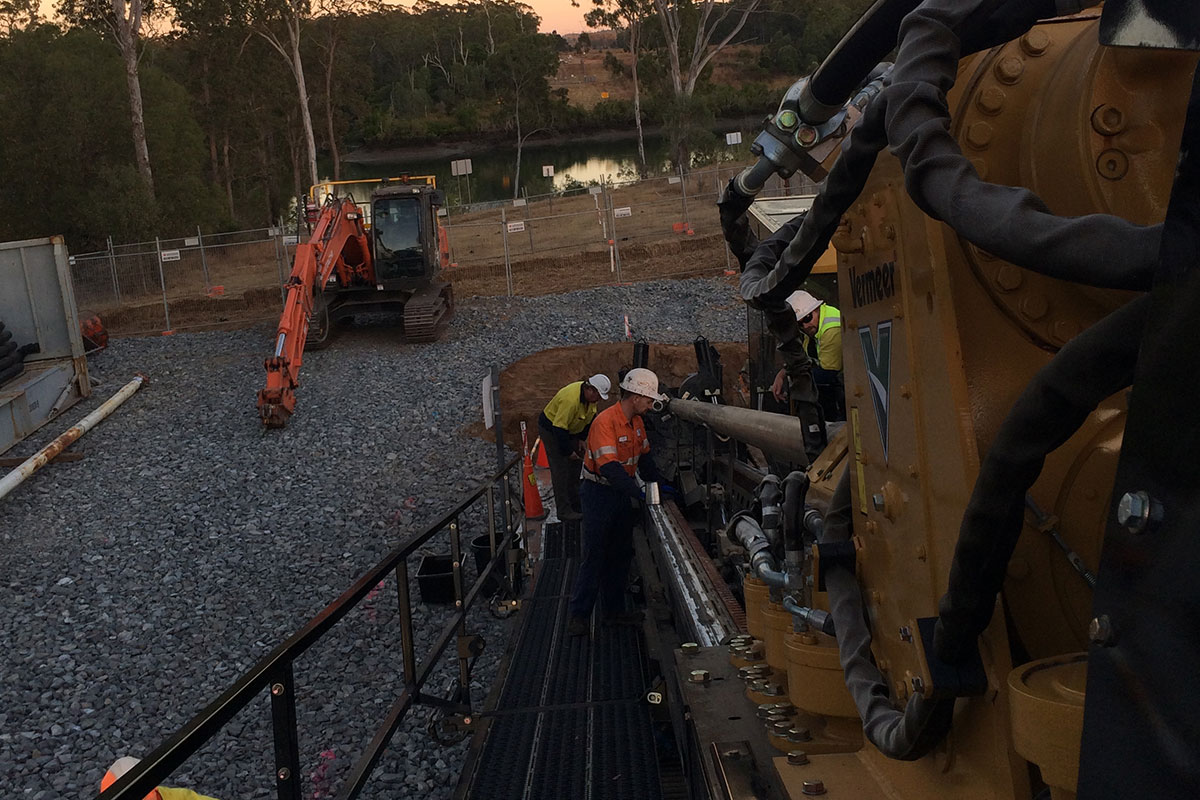Mar 4, 2015 – A recent bout of heavy rains saw Queensland’s Kolan River, located approximately 22 km west of the coastal city of Bundaberg, subjected to a considerable amount of flooding. After these floodwaters had receded, it was discovered that the subsequent erosion and land slip of the river bed and its banks had uncovered a section of APA Group’s DN 100 Wide Bay Gas Pipeline (WBGP).
The WBGP pipeline was constructed in 1999 using conventional open ‘cut and cover’ techniques whilst the state was experiencing a prolonged dry period. The 3.275 Trilaminate-coated pipeline had a diameter of 114 mm, a wall thickness of 6 mm, and an API 5L Grade X52 ERW PSL2. With the erosion of the river bed following the flooding, leaving the pipeline insufficiently covered, replacement of the pipeline was deemed necessary. This time around, however, horizontal directional drilling (HDD) was found to be the preferred installation method instead of another open-cut operation.
The work was carried out by HDD specialists Australia Wide Directional Drilling (AWDD) using an equipment package supplied by Vermeer Australia. After a thorough survey of the area’s conditions and composition, intersect drilling methodology was selected.
COBBLED TOGETHER
Situated in a rural location amongst farms of sugar cane, the Kolan River itself was approximately 400 m wide with only 100 m of holding water, explained AWDD Business Development Manager Josh Taylor. The remaining 300 m was dry riverbed that had previously been mined for sand.
“The geology was interpreted from the boreholes, which were drilled during the geotechnical investigation,” said Mr Taylor.
“The investigation indicated the presence of a competent rock layer approximately 4 m below the Australian Height Datum (AHD). However, this was overlaid with substantial layers of gravel and cobble.”
These gravel/cobble layers occurred between depths of approximately 1 m above AHD to -4.5 m below AHD on the southern side of the crossing, 5 m above to 4.5 m below in the centre of the crossing, and 4-8 m above on the northern side of the crossing. An additional cobble layer was also located on the northern side of the crossing at depths of between 3-4 m below AHD.
Despite the added challenge of these layers, the identified competent rock layer comprised medium-to-high strength siltstone/sandstone and provided ideal drilling conditions, said Mr Taylor.
“With limited fractures and high resistance to borehole collapse, the bore probe was designed to stay in this rock layer as much as possible,” he said.
GEARING UP WITH VERMEER
The choice of an intersect drilling methodology to complete the crossing was made after a review of the supplied design and geotechnical report from APA Group by Western Australian engineering consultant Atteris.
According to Mr Taylor, intersect drilling was chosen due to the possibility of having to install a casing from each side, as well as the reduced likelihood of frac-out when exiting through the ground conditions if conventional HDD pilot methods were used.
AWDD mobilised two complete drilling spreads to complete the crossing. At the entry side, a Vermeer D330x500 Drill rig was combined with a Vermeer R9x12T fluid recycler, a Vermeer SA400 mud pump, 12.7 cm (5 inch) drill rod, a 16.5 cm (6.5 inch) mud motor, a Vermeer vacuum truck, and site containers. The exit side, meanwhile, utilised a Vermeer D100x120 drill rig, Vermeer R9x12T fluid recycler, 12 cm (4.75 inch) mud motor, Vermeer vacuum truck and site containers.
Drilling contractor Prime Horizontal were engaged to carry out the ‘steering’/survey of the crossing. A ParaTrack 2 guidance system was also used at both sides of the river, and an AC beacon was deployed to cross the river’s inaccessible section. Due to the approximately 300 m of dry river bed at the site, a ground coil was able to be deployed, thus allowing the intersect of the two bores to be completed within the section, said Mr Taylor.
MINIMAL INTRUSION, MAXIMUM RESULT
Thanks to the utilisation of HDD, the overall environmental impact of the project was minimal, concluded Mr Taylor. There was no need to disturb the river banks and, as a consequence, there was no pollution of the Kolan River nor the likely prospect of future erosion problems.
Commenting on any particular challenges experienced during the project, Mr Taylor said the gravel/ cobble layers had provided some degree of difficulty on the exit side of the bore.
“However, these were able to be kept in check by keeping to the engineered mud program supplied by AMC and the determination of AWDD sta to achieve a positive outcome.”

 MyDealer:
MyDealer: